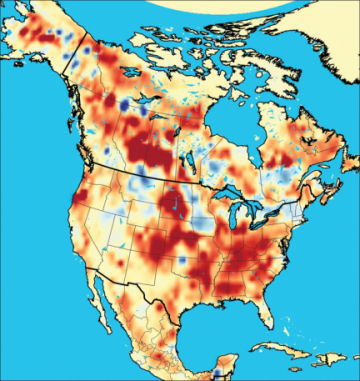Long-term growth of North America’s vegetation soaks up millions of tons of carbon dioxide from the atmosphere each year. Though impressive, that rate doesn’t keep pace with the prodigious emissions of the planet-warming gas due to human activity.

Scientists have several ways of monitoring the movement of carbon through the world’s ecosystems. So-called bottom-up approaches entail comprehensive and repeated inventories of the amount of carbon in trees, soil, water, minerals, and other natural reservoirs. Such analyses hint that about half of human-generated emissions of carbon dioxide are sequestered in vegetation or soaked up by the ocean, says Andrew R. Jacobson, an atmospheric scientist with the National Oceanic and Atmospheric Administration in Boulder, Colo.
Another, less direct technique involves tracking long-term variations in global and regional concentrations of carbon dioxide in the air. Scientists use such information to estimate carbon fluxes between vegetation, ocean, and atmosphere. Analyzing more than 28,000 measurements taken at hundreds of locations worldwide from 2000 through 2005, Jacobson and his colleagues were able to calculate weekly changes in carbon flux across North America during that period.
On average, North American ecosystems stored more than 650 million metric tons of carbon each year, says Jacobson. Most of that was sequestered in vegetation east of the Rockies, he and his colleagues estimate in the Nov. 27 Proceedings of the National Academy of Sciences. About 32 percent of the carbon ended up in the deciduous forests of the eastern United States, and about 22 percent was stored in high-latitude conifers, they report.
The researchers estimate that about 11 percent of the carbon dioxide that North American ecosystems sopped up each year from 2000 to 2005 ended up in crops. That sequestration, however, was likely short-lived: Most of the harvest was soon eaten by humans or other animals who returned its stored carbon to the atmosphere, Jacobson notes.
Carbon storage in North American ecosystems isn’t keeping up with carbon dioxide emissions from the continent’s automobiles and power plants. Those fossil fuel burners, plus the manufacturing of cement, spew more than 1.8 billion metric tons of carbon from North America into the atmosphere each year.
In 2002, North America suffered one of its most significant dry spells in a century, with more than 45 percent of the continent experiencing severe drought. That year, ecosystems absorbed less than half as much carbon dioxide as in other years during the study period, Jacobson and his colleagues estimate.
Many global warming skeptics have argued that Earth’s ecosystems can absorb copious amounts of human-generated carbon dioxide. However, “these results indicate that if climate change persists, our carbon sinks are at risk,” says Lisa Dilling, a policy researcher at the University of Colorado at Boulder.
The new findings are “interesting, and in line with the bottom-up estimates of other studies,” says Richard A. Houghton, an ecologist at the Woods Hole Research Center in Falmouth, Mass. Comparing the team’s detailed results with those produced by other groups may provide clues about environmental processes that are poorly estimated in various models or missing from them, he adds.






